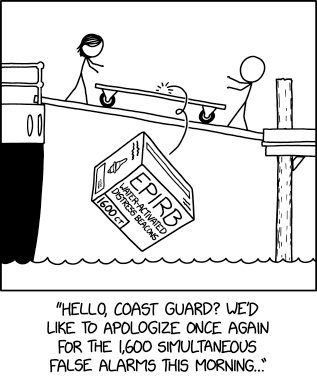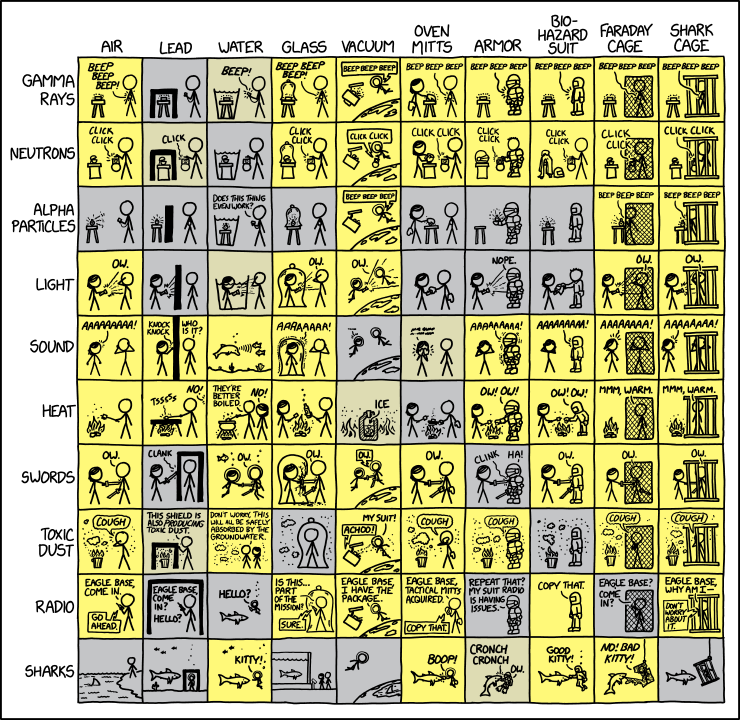@shinyoukai@neko.laidback.moe I think I never watched it. In any case, enjoy reading your books.
Jumping Frog Radius
 ⌘ Read more
⌘ Read more
Apples
 ⌘ Read more
⌘ Read more
@lyse@lyse.isobeef.org It was too late when I read the “Addictive” warning… 😆 Thanks for sharing this!
Fishing
 ⌘ Read more
⌘ Read more
Hyperacute Interdynamics
 ⌘ Read more
⌘ Read more
I kind of hate conventional commit messages: https://www.conventionalcommits.org/en/v1.0.0/#summary
but I am loving reading RFC 2119: https://www.ietf.org/rfc/rfc2119.txt
@movq@www.uninformativ.de how long do they need to read the scale? LOL. The penguin stayed put at least twice, no issues. I think the creator wanted some Internet points out of that video. 😂
Chessboard Alignment
 ⌘ Read more
⌘ Read more
Gootosocial to a Pleroma one. While GTS is kinda cute (lightweight and easy to manage) of a software, the inability to fetch/scroll through people's past toots when visiting a profile or having access to a federated timeline and a proper search functionality ...etc felt like handicap for the past N months.
@bender@twtxt.net yeah, I’ve been reading through the documentation last night and it felt overwhelming for a minute… +1 point goes to GTS’s docs. but hey, I’ll be taking the easy route: podman-compose up -d they provide both a container image and an example compose file in a separate git repo but I’m wondering why that is not mentioned anywhere in the docs, (unless it is and I haven’t seen it yet)
Inverted Catenaries
 ⌘ Read more
⌘ Read more
Website Task Flowchart
 ⌘ Read more
⌘ Read more
Bridge Clearance
 ⌘ Read more
⌘ Read more
git.mills.io today (after finishing work) and this is what I found 🤯 Tehse asshole/cunts are still at it !!! 🤬 -- So let's instead see if this works:
@prologic@twtxt.net I remember reading a blog-post where someone has been throwing redirects to some +100GB files (usually used for speed testing purposes) at a swarm of bots that has been abusing his server in order to criple them, but I can’t find it anymore. I’m pretty sure I’ve had it bookmarked somewhere.
@aelaraji@aelaraji.com Ahh that would be awesome!!! I’d also somehow need read access to logs so i can figure shit out on my own 🧐
@iolfree@tilde.club @movq@www.uninformativ.de So true! Good read, thanks for recommending. :-)
Satellite Imagery
 ⌘ Read more
⌘ Read more
Fifteen Years
 ⌘ Read more
⌘ Read more
All my newly added test cases failed, that movq thankfully provided in https://git.mills.io/yarnsocial/twtxt.dev/pulls/28#issuecomment-20801 for the draft of the twt hash v2 extension. The first error was easy to see in the diff. The hashes were way too long. You’ve already guessed it, I had cut the hash from the twelfth character towards the end instead of taking the first twelve characters: hash[12:] instead of hash[:12].
After fixing this rookie mistake, the tests still all failed. Hmmm. Did I still cut the wrong twelve characters? :-? I even checked the Go reference implementation in the document itself. But it read basically the same as mine. Strange, what the heck is going on here?
Turns out that my vim replacements to transform the Python code into Go code butchered all the URLs. ;-) The order of operations matters. I first replaced the equals with colons for the subtest struct fields and then wanted to transform the RFC 3339 timestamp strings to time.Date(…) calls. So, I replaced the colons in the time with commas and spaces. Hence, my URLs then also all read https, //example.com/twtxt.txt.
But that was it. All test green. \o/
Geologic Core Sample
 ⌘ Read more
⌘ Read more
Service Outage
 ⌘ Read more
⌘ Read more
EPIRBs
 ⌘ Read more
⌘ Read more
I like to read through old RPG books and zines for inspiration for my games, and lately I’ve been enjoying the Arduin Grimoire (https://en.wikipedia.org/wiki/Arduin), one of the earliest 3rd-party zines (coming out during the initial run of OD&D). It’s filled with a bunch of unique ideas (some better than others), entirely too many charts, and is very much a product of its time, but there’s something about its “raw”-ness (and its variety) that I still find appealing.
Beam Dump
 ⌘ Read more
⌘ Read more
Car Size
 ⌘ Read more
⌘ Read more
I used Gemini (the Google AI) twice at work today, asking about Google Workspace configuration and Google Cloud CLI usage (because we use those a lot). You’d think that it’d be well-suited for those topics. It answered very confidently, yet completely wrong. Just wrong. Made-up CLI arguments, whatever. It took me a while to notice, though, because it’s so convincing and, well, you implicitly and subconsciously trust the results of the Google AI when asking about Google topics, don’t you?
Will it get better over time? Maybe. But what I really want is this:
- Good, well-structured, easy-to-read, proper documentation. Google isn’t doing too bad in this regard, actually, it’s just that they have so much stuff that it’s hard to find what you’re looking for. Hence …
- … I want a good search function. Just give me a good fuzzy search for your docs. That’s it.
I just don’t have the time or energy to constantly second-guess this stuff. Give me something reliable. Something that is designed to do the right thing, not toy around with probabilities. “AI for everything” is just the wrong approach.
access.log files. Hence they’ll never see followers, unless we notify them out of band. 🫤
I mean, granting everyone read access, maybe?
Big and Little Spoons
 ⌘ Read more
⌘ Read more
Thanks for sharing your thoughts! I’m going to bed, but I’ll have a closer read/think tomorrow 🤞
… and now I just read @bender@twtxt.net’s other post that said the Gemini text was a shortened version, so I might have criticized things that weren’t true for the full version. Okay, sorry, I’m out. (And I won’t play that game, either. Don’t send me another AI output, possibly tweaked to address my criticism. That is besides the point and not worth my time.)
@prologic@twtxt.net Let’s go through it one by one. Here’s a wall of text that took me over 1.5 hours to write.
The criticism of AI as untrustworthy is a problem of misapplication, not capability.This section says AI should not be treated as an authority. This is actually just what I said, except the AI phrased/framed it like it was a counter-argument.
The AI also said that users must develop “AI literacy”, again phrasing/framing it like a counter-argument. Well, that is also just what I said. I said you should treat AI output like a random blog and you should verify the sources, yadda yadda. That is “AI literacy”, isn’t it?
My text went one step further, though: I said that when you take this requirement of “AI literacy” into account, you basically end up with a fancy search engine, with extra overhead that costs time. The AI missed/ignored this in its reply.
Okay, so, the AI also said that you should use AI tools just for drafting and brainstorming. Granted, a very rough draft of something will probably be doable. But then you have to diligently verify every little detail of this draft – okay, fine, a draft is a draft, it’s fine if it contains errors. The thing is, though, that you really must do this verification. And I claim that many people will not do it, because AI outputs look sooooo convincing, they don’t feel like a draft that needs editing.
Can you, as an expert, still use an AI draft as a basis/foundation? Yeah, probably. But here’s the kicker: You did not create that draft. You were not involved in the “thought process” behind it. When you, a human being, make a draft, you often think something like: “Okay, I want to draw a picture of a landscape and there’s going to be a little house, but for now, I’ll just put in a rough sketch of the house and add the details later.” You are aware of what you left out. When the AI did the draft, you are not aware of what’s missing – even more so when every AI output already looks like a final product. For me, personally, this makes it much harder and slower to verify such a draft, and I mentioned this in my text.
Skill Erosion vs. Skill EvolutionYou, @prologic@twtxt.net, also mentioned this in your car tyre example.
In my text, I gave two analogies: The gym analogy and the Google Translate analogy. Your car tyre example falls in the same category, but Gemini’s calculator example is different (and, again, gaslight-y, see below).
What I meant in my text: A person wants to be a programmer. To me, a programmer is a person who writes code, understands code, maintains code, writes documentation, and so on. In your example, a person who changes a car tyre would be a mechanic. Now, if you use AI to write the code and documentation for you, are you still a programmer? If you have no understanding of said code, are you a programmer? A person who does not know how to change a car tyre, is that still a mechanic?
No, you’re something else. You should not be hired as a programmer or a mechanic.
Yes, that is “skill evolution” – which is pretty much my point! But the AI framed it like a counter-argument. It didn’t understand my text.
(But what if that’s our future? What if all programming will look like that in some years? I claim: It’s not possible. If you don’t know how to program, then you don’t know how to read/understand code written by an AI. You are something else, but you’re not a programmer. It might be valid to be something else – but that wasn’t my point, my point was that you’re not a bloody programmer.)
Gemini’s calculator example is garbage, I think. Crunching numbers and doing mathematics (i.e., “complex problem-solving”) are two different things. Just because you now have a calculator, doesn’t mean it’ll free you up to do mathematical proofs or whatever.
What would have worked is this: Let’s say you’re an accountant and you sum up spendings. Without a calculator, this takes a lot of time and is error prone. But when you have one, you can work faster. But once again, there’s a little gaslight-y detail: A calculator is correct. Yes, it could have “bugs” (hello Intel FDIV), but its design actually properly calculates numbers. AI, on the other hand, does not understand a thing (our current AI, that is), it’s just a statistical model. So, this modified example (“accountant with a calculator”) would actually have to be phrased like this: Suppose there’s an accountant and you give her a magic box that spits out the correct result in, what, I don’t know, 70-90% of the time. The accountant couldn’t rely on this box now, could she? She’d either have to double-check everything or accept possibly wrong results. And that is how I feel like when I work with AI tools.
Gemini has no idea that its calculator example doesn’t make sense. It just spits out some generic “argument” that it picked up on some website.
3. The Technical and Legal Perspective (Scraping and Copyright)The AI makes two points here. The first one, I might actually agree with (“bad bot behavior is not the fault of AI itself”).
The second point is, once again, gaslighting, because it is phrased/framed like a counter-argument. It implies that I said something which I didn’t. Like the AI, I said that you would have to adjust the copyright law! At the same time, the AI answer didn’t even question whether it’s okay to break the current law or not. It just said “lol yeah, change the laws”. (I wonder in what way the laws would have to be changed in the AI’s “opinion”, because some of these changes could kill some business opportunities – or the laws would have to have special AI clauses that only benefit the AI techbros. But I digress, that wasn’t part of Gemini’s answer.)
tl;drExcept for one point, I don’t accept any of Gemini’s “criticism”. It didn’t pick up on lots of details, ignored arguments, and I can just instinctively tell that this thing does not understand anything it wrote (which is correct, it’s just a statistical model).
And it framed everything like a counter-argument, while actually repeating what I said. That’s gaslighting: When Alice says “the sky is blue” and Bob replies with “why do you say the sky is purple?!”
But it sure looks convincing, doesn’t it?
Never againThis took so much of my time. I won’t do this again. 😂
@movq@www.uninformativ.de I am genuinely curious as to why you think Geminis summarization and the categorization of your gopher post was and is as you say misunderstood?
I asked this very genuinely because before reading @bender@twtxt.net’s comments and Gemini summarization I actually went and unplugged your post into flood gaps go for proxy, and then listen to the text intently with my own human ears 👂
Earthquake Prediction Flowchart
 ⌘ Read more
⌘ Read more
Metric Tip
 ⌘ Read more
⌘ Read more
Repair Video
 ⌘ Read more
⌘ Read more
@aelaraji@aelaraji.com Oh nice, I’ll have to read this!
Heart Mountain
 ⌘ Read more
⌘ Read more
@movq@www.uninformativ.de Yeah, give it a shot. At worst you know that you have to continue your quest. :-)
Fun fact, during a semester break I was actually a little bored, so I just started reading the Qt documentation. I didn’t plan on using Qt for anything, though. I only looked at the docs because they were on my bucket list for some reason. Qt was probably recommended to me and coming from KDE myself, that was motivation enough to look at the docs just for fun.
The more I read, the more hooked I got. The documentation was extremely well written, something I’ve never seen before. The structure was very well thought out and I got the impression that I understood what the people thought when they actually designed Qt.
A few days in I decided to actually give it a real try. Having never done anything in C++ before, I quickly realized that this endeavor won’t succeed. I simply couldn’t get it going. But I found the Qt bindings for Python, so that was a new boost. And quickly after, I discovered that there were even KDE bindings for Python in my package manager, so I immediately switched to them as that integrated into my KDE desktop even nicer.
I used the Python KDE bindings for one larger project, a planning software for a summer camp that we used several years. It’s main feature was to see who is available to do an activity. In the past, that was done on a large sheet of paper, but people got assigned two activities at the same time or weren’t assigned at all. So, by showing people in yellow (free), green (one activity assigned) and red (overbooked), this sped up and improved the planning process.
Another core feature was to generate personalized time tables (just like back in school) and a dedicated view for the morning meeting on site.
It was extended over the years with all sorts of stuff. E.g. I then implemented a warning if all the custodians of an activitiy with kids were underage to satisfy new the guidelines that there should be somebody of age.
Just before the pandemic I started to even add support for personalized live views on phones or tablets during the planning process (with web sockets, though). This way, people could see their own schedule or independently check at which day an activity takes place etc. For these side quests, they don’t have to check the large matrix on the projector. But the project died there.
Here’s a screenshot from one of the main views: https://lyse.isobeef.org/tmp/k3man.png
This Python+Qt rewrite replaced and improved the Java+Swing predecessor.
@lyse@lyse.isobeef.org now that I could finally read you RSVP message (or, should I say, essay, LOL), I had to see the video, and well, https://netbros.com/1761846417/. Hahahahaha!
Airspeed
 ⌘ Read more
⌘ Read more
Document Forgery
 ⌘ Read more
⌘ Read more
Continents
 ⌘ Read more
⌘ Read more
This was a great read, btw. 😃 If you liked Event Horizon, this is for you. I’m gonna get her other two scifi books as well, that’s for sure.
Shielding Chart
 ⌘ Read more
⌘ Read more
Emperor Palpatine
 ⌘ Read more
⌘ Read more
Planetary Rings
 ⌘ Read more
⌘ Read more
Physics Paths
 ⌘ Read more
⌘ Read more
Physics Insight
 ⌘ Read more
⌘ Read more
Hot Water Balloon
 ⌘ Read more
⌘ Read more
Skateboard
 ⌘ Read more
⌘ Read more